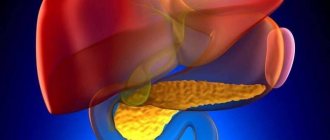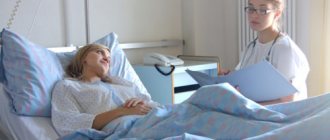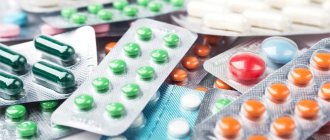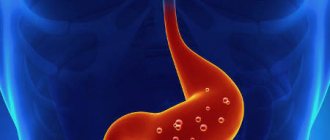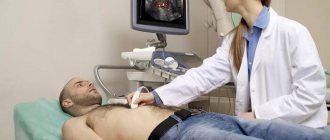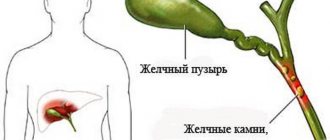Biliary pancreatitis is considered as a secondary inflammatory lesion of the pancreas in pathology of the liver and biliary tract (hepatobiliary system). This is a type of chronic pancreatic disease in which each exacerbation follows or coincides with attacks of cholelithiasis (reported by different authors from 25 to 90%).
There is a 3-fold increase in this type of pancreatitis among adults, and a 4-fold increase in children. Observations associate it with the refusal of patients to undergo surgical treatment when there is documented migration of stones along the bile ducts due to hopes for conservative therapy.
Obese women are more likely to get sick. Some authors argue that biliary-dependent changes in the pancreas are in first place in terms of the frequency of damage, displacing alcoholic pancreatitis.
ICD-10 practically does not explain what biliary pancreatitis is. According to the type of course, it can be classified as acute and chronic. And according to code K 86.1 - “other pancreatitis” without specifying the origin.
What is biliary pancreatitis in more detail?
This pathology is a persistent disease of the pancreas, which is inextricably linked with inflammatory and other pathologies of the hepatobiliary system. A common cause of biliary pancreatitis is cholelithiasis; if present, pancreatitis is diagnosed in 25-90% of cases. Biliary pancreatitis is considered a secondary disease. The development of biliary pancreatitis can occur in acute or chronic form. Women suffer from it more often.
Exacerbation of biliary pancreatitis most often depends on the movement of stones along the biliary tract. In this case, surgical intervention is used; if surgery is refused and colic recurs, surgical intervention may be slightly wider.
Preventive measures and complications
If the disease is detected early and treatment is started, severe complications can be prevented.
Prevention rules:
- Treat concomitant diseases in a timely manner.
- Carry out secondary prevention to prevent exacerbation of chronic pathology.
- Avoid harmful foods.
- Stick to proper nutrition.
- Do not take long-term medications that have a negative effect on the pancreas.
As complications, there is a risk of gallstones moving. In this case, doctors perform immediate surgery.
Causes of pathology
Biliary pancreatitis can develop with the following diseases:
- structural anomalies of the pancreatic and bile ducts;
- cholelithiasis;
- chronic cholecystitis;
- cirrhosis of the liver;
- gallbladder dysfunction;
- progression of hepatic exocrine insufficiency;
- pathology of the Vater's nipple;
- helminthic infestations.
Exacerbation of biliary pancreatitis can be caused by the use of choleretic medications or foods, or sudden weight loss.
The secondary nature of biliary pancreatitis as a disease is explained by the fact that the pathology is not the result of inflammation of the pancreas, but arises as a result of functional failures that occur in nearby organs.
Definition of illness
Biliary pancreatitis is an inflammation of the pancreas due to problems with the gallbladder and liver. This disease is often combined with other pathologies of the digestive system. The disease occurs more often than other inflammatory lesions of the gastrointestinal tract. This type of pancreatitis develops for various reasons. The first is the entry of bile into the pancreas. This is possible in the presence of an inflammatory process in the gallbladder. In this case, the outflow of secretion occurs unevenly.
The second reason is the presence of stones, which create untimely and improper discharge of bile. Biliary pancreatitis occurs in 60% of cases of liver problems. This is especially true when a bacterial infection is attached.
If liver pathologies progress, the disease is aggravated by the presence of free radicals that enter from the bile ducts directly into the pancreas. A long course of cholecystitis in the absence of stones leads to a change in the composition of the secretion, which, with prolonged stagnation in the organ, contributes to the formation of flakes. They are deposited in the gallbladder and, as they progress, can lead to injury to the ducts, which subsequently begin to narrow due to scarring. In this case, an uneven reflux of bile into the duodenum occurs. As a result, the secretion enters the pancreatic ducts and leads to its inflammation.
Biliary pancreatitis can be triggered by dyskinesia of the gallbladder, a sharp decrease in body weight, as well as the presence of hepatitis and cirrhosis of the liver. Taking certain medications can also cause the disease. This is especially true when treating with choleretic drugs.
Types of pathologists
There are acute biliary pancreatitis and chronic biliary-dependent pancreatitis:
- Chronic biliary-dependent pancreatitis is characterized by its long course - more than six months. This form is quite common. Chronic biliary-dependent pancreatitis is characterized by discomfort in the abdomen, aching pain that bothers the patient for a long time, the presence of dyspeptic symptoms, loose stools, jaundice, and weight loss. Chronic biliary pancreatitis is characterized by chronic constipation or diarrhea.
- an acute type of pathology appears as a result of inflammation of the biliary tract and, without treatment, often leads to death. During the acute stage, the patient has slight hyperthermia, usually within subfebrile levels. Also, the acute course is characterized by the following symptoms: pain localized in the area of the left hypochondrium, encircling in nature;
- constant nausea with intense vomiting;
- yellowing of the skin;
- increased gas formation, constipation or diarrhea.
The danger of biliary pancreatitis is the irreversibility of changes in the pancreas.
Diagnostic methods
To make an accurate diagnosis, a complex of laboratory and instrumental techniques is used. Laboratory research methods include general clinical and biochemical tests of blood, urine and feces. In biliary acute pancreatitis, leukocytosis is detected in the blood and the ESR increases. In the case of a protracted chronic process, their decrease relative to the norm is noted.
Biochemical blood parameters allow you to assess the condition of the biliary system, liver and pancreas:
- During an exacerbation, the content of total protein and globulins in the blood increases, and the level of albumin decreases.
- The amount of amylase enzyme in the blood and urine, which is responsible for the breakdown of carbohydrates in the intestines, increases.
- The activity of lipase in the blood, which is involved in the breakdown of lipids, increases.
- Bilirubin levels increase. This indicates swelling of the gland, which prevents the release of bile into the intestines.
- Stagnation of bile in the biliary system is indicated by a significant increase in the activity of the enzyme glutamyl transpeptidase.
- An increase in alkaline phosphatase activity indicates pathologies of the biliary organs.
- The function of the pancreas can be assessed by glucose levels in the blood and urine.
- Evidence of the biliary type of pancreatitis is an increase in the blood levels of cholesterol and transaminases (ALT and AST).
At the same time, a stool analysis is carried out: with this disease, it is very light with an oily sheen.
The initial diagnosis is made at the stage of visual examination of the patient, collection of anamnesis and palpation examination of the peritoneal cavity.
The test results are confirmed by instrumental diagnostic methods:
- Ultrasound reveals swelling of the pancreas, the presence of stones and concretions in the organs of the biliary system, focal or diffuse changes in the liver and pancreas.
- Computed tomography with the introduction of a contrast agent shows the slightest changes in the pancreas, liver, pancreatic and biliary ducts.
- MRI of the abdominal organs reveals inflammatory processes, the presence of stones, and changes in the biliary system.
- Endoscopic retrograde cholangiopancreatography is used to diagnose pathologies of the biliary and pancreatic ducts and stone formation.
Symptoms of the disease, results of laboratory and instrumental studies allow us to establish an accurate diagnosis and begin therapy.
Pathogenesis of biliary pancreatitis
There are several ways in which biliary pancreatitis occurs:
- The first way is the spread of infection through the lymphatic tract from the gallbladder to the pancreas.
- The second is formed when stones are present in the common bile duct, which leads to the appearance of hypertension in the pancreas ducts.
- The third way of formation of biliary pancreatitis is the throwing of bile into the pancreatic ducts due to pathology of the papilla of Vater.
- Another mechanism for the onset of inflammation was also discovered - the formation of biliary sludge.
Sources of the disease
The main reasons for the development of biliary pancreatitis are as follows:
- Gallstone disease - with it, stagnation of bile occurs as a result of blockage of the bile ducts with a stone, which entails an increase in intrapancreatic pressure, while bile is thrown into the pancreas.
- Cholecystitis is an inflammatory swelling process on the surface of the gallbladder, which causes an obstruction to the flow of bile.
- Cholangitis is an uncharacteristic inflammation of the bile ducts caused by obstruction of the bile ducts and infection of the bile itself.
?enablejsapi=1″>
?enablejsapi=1″>
?enablejsapi=1″>
?enablejsapi=1″>
05/31/16 Biliary-dependent pancreatitis and liver steatosis, part 1
Symptoms of biliary pancreatitis
The clinical manifestations of biliary pancreatitis are similar to other gastrointestinal diseases: antral, viral gastritis, gastric and duodenal ulcers, intestinal tumors, chronic acalculous cholecystitis and others.
In the vast majority of cases, the main symptom of pancreatitis is pain. Pain in the abdominal area can be felt in the epigastrium, radiating to the hypochondrium, back, and right shoulder. Most often, pain appears a few hours after eating food or at night, after drinking drinks with gas that cause spasm of the sphincter of Oddi.
Pain often appears after a diet break. The pain may be accompanied by fever, nausea, and a feeling of bitterness in the mouth. Obstructive jaundice may occur - when the papilla of Vater is completely blocked by a stone - yellowing of the skin and mucous membranes occurs.
During the inflammatory process in the tissues of the pancreas, its endo- and exocrine functions malfunction. Endocrine disorders are characterized by disturbances in carbohydrate metabolism, and exocrine disorders are characterized by pancreatic enzyme deficiency with subsequent disturbances in the digestive process. Such a patient has loose stools several times a day, the stool has a grayish color, a greasy consistency, and a foul odor.
Rumbling in the stomach, flatulence are disturbing; in addition, belching, heartburn, and lack of appetite are observed. Against the background of increased fat loss, diarrhea, and failure of the digestive process, body weight loss occurs.
In addition to the similarity of the clinical picture, there are also features in the symptoms:
- pain in the abdominal area, which is caused by taking medications and foods with a choleretic effect;
- duration of pain attacks. Pain lasts much longer compared to other pathologies;
- the appearance of paresis in the intestinal area. In most cases, this type of pancreatitis occurs with the formation of constipation, other forms of the disease cause diarrhea;
- pain in the right hypochondrium, they resemble biliary colic;
- development of jaundice;
- regular belching with a bitter taste, bitterness in the mouth.
Symptoms
The main symptom of biliary pancreatitis is pain. Localization of pain can occur in the left or right hypochondrium. The attacks resemble short-term spasms or are regular. A provoking factor for pain syndrome is the consumption of certain categories of food (for example, salty, spicy, fatty or fried foods).
Other symptoms of PD may vary depending on the stage of the disease and the overall health of the digestive system.
Main symptoms:
yellowness of the skin and sclera;- attacks of vomiting combined with attacks of pain localized in the digestive organs;
- frequent urge to defecate (loose stools, particles of undigested food may be present in the stool);
- heaviness in the stomach (with regular pain);
- lack of appetite (an inevitable consequence of the symptom is weight loss);
- regular attacks of nausea and uncontrollable vomiting;
- depressive disorders;
- increased body temperature;
- pain in the joints;
- general weakness of the body and excessive fatigue.
Distinctive features of PD are a feeling of bitterness in the mouth (or bitter belching) and regular constipation. Against the background of regular difficulties in the process of bowel movement, the patient may develop intestinal obstruction. Painful attacks with biliary-dependent pancreatitis last longer than other forms of this disease.
The pain is most often localized in the right hypochondrium (rather than in the left) and can move to the right arm, lower back or right shoulder blade.
How to treat
Symptoms, and therefore treatment, are somewhat different for different types of biliary pancreatitis. The main condition for stopping the formation of biliary pancreatitis and preventing exacerbations is considered to be treatment of the underlying disease. If necessary, stones are removed or the condition of the Vater's nipple is improved (usually by an endoscopic method).
In case of exacerbation of biliary pancreatitis, therapy consists of pain relief (analgesics and antispasmodics are taken), correction of internal and external secretory functions of the pancreas, detoxification, prevention of infectious complications (antibiotics are taken).
In the first three days of an exacerbation, therapeutic fasting is recommended; you can drink alkaline mineral water, only non-carbonated. Food should be consumed in small portions, observing the principles of mechanical and thermal sparing.
To reduce the destructive effects of activated pancreatic enzymes, take Somatostatin and proton pump inhibitors - Omeprazole, Nolpaza, Emanera, with the help of which the process of hydrochloric acid synthesis is stabilized. To normalize enzymatic dysfunction of the pancreas, microspherical enzymes are prescribed, and blood sugar levels are prescribed hypoglycemic drugs.
In the acute phase of biliary pancreatitis, choleretic drugs are used. To increase the functional activity of the pancreas, take enzymatic medications “Creon”, “Pancreatin”, “Mezim”.
In case of a chronic course, medications are prescribed that help normalize the outflow of bile - usually these are herbal products - "Hofitol".
Surgical intervention is performed only in the presence of stones and pathology of the sphincter of Oddi. Indications for surgery are considered to be advanced types of gallstone pathology, when the stones are large, cannot be crushed by ESWL, and block the bile ducts. In this case, cholecystectomy (resection of the gallbladder with stones) is performed. The operation is also performed when an adenoma forms, which is located in the area of the nipple of Vater, in the presence of strictures or cicatricial narrowings.
Types of surgery:
- laparoscopy (surgery is performed through small incisions in the peritoneal wall);
- lithotripsy (crushing stones using special devices);
- laparotomy (the procedure is intended to remove the gallbladder and stones).
Diet for pathology
Treatment of biliary pancreatitis involves strict adherence to a diet. Diet No. 5 is usually prescribed. In the acute phase or relapse of the chronic course, a three-day fast is prescribed, and after three days the prescribed diet should be followed.
The diet implies adherence to the following rules for eating:
- all dishes must be prepared by stewing, boiling or steaming;
- food temperature – room temperature;
- the interval between meals is at least 3 hours;
- when eating food, you must chew it thoroughly (the dishes themselves should have the consistency of mousses or purees);
- You should not wash down your food (liquids should be consumed an hour after meals).
- eat in small portions, at least 5 times a day.
The list of prohibited products includes:
- fatty, fried, spicy foods;
- alcoholic drinks;
- sour juices;
- fruit and berry jelly;
- White cabbage;
- nuts;
- legumes;
- strong coffee, tea, carbonated drinks.
The following products and dishes are allowed for consumption:
- soups with cereals (during a period of stable remission - with milk), from vegetables;
- boiled beef, poultry, lean fish;
- steamed omelette made from egg whites;
- porridge;
- vegetable oils;
- pasta;
- sweet berries and fruits;
- yesterday's bread;
- low-fat fermented milk products, butter (daily intake no more than 0.25 g);
- honey;
- freshly squeezed sweet fruit juices without sugar, vegetable juices, jelly, compotes.
An approximate menu for the day could be like this:
- Breakfast. Oatmeal porridge with diluted milk, boiled beef, green tea;
- Lunch. Steam omelette, baked apple, jelly;
- Dinner. Vegetable soup, fish fillet meatballs, pasta, jelly, rosehip infusion;
- Afternoon snack. Cottage cheese with biscuits;
- Dinner. Rice porridge and green tea.
You can also create a menu for the whole week, diversifying it with various permitted dishes.
The duration of the diet is influenced by the clinical picture of the patient’s general health. In some cases, adherence to dietary principles is required throughout life.
Folk remedies
The use of folk remedies is considered an addition to the main treatment. Decoctions from recommended plants are prepared according to the standard procedure - 1 teaspoon of the plant is brewed with boiling water, infused and taken in small portions.
The following types of herbs are recommended for the treatment of biliary pancreatitis:
- fennel;
- calendula;
- dandelion;
- celandine;
- tansy;
- immortelle;
- corn silk;
- peppermint.
Is it possible to cure
Treatment of biliary pancreatitis is long and complex. An endoscopist, surgeon and gastroenterologist take part in the process. Therapy is aimed at getting rid of the underlying disease that caused chronic inflammation of the gland and restoring the functioning of the biliary tract, liver, and gallbladder.
The fundamental aspects of treatment are subject to general rules, among which can be noted a reduction in pain, enzyme replacement therapy, a strict therapeutic diet, giving up bad habits (alcohol, smoking), and fortification of the body.
During the period of exacerbation (the first three days), the patient is prohibited from eating - therapeutic fasting is carried out. To avoid dehydration, it is recommended to maintain a hydration regime and drink at least 1.5-2 liters of liquid (medium or low-mineralized still water). Next, the patient is transferred to the 5P diet, based on split five meals a day and excluding the intake of fatty, spicy, fried foods. The consumption of fats and carbohydrates should be kept to a minimum, and proteins should predominate in the menu.
Prohibited products include products with a choleretic effect:
- egg yolks;
- cabbage;
- tomatoes;
- oil (vegetable, butter);
- greenery.
Vegetables and fruits are allowed only in processed form. Food is served in crushed form; preference should be given to the steam cooking method.
It is important that patients who have suffered biliary pancreatitis will have to follow a rational diet throughout their lives. It implies some expansion of the diet during the period of remission and strict restrictions during the acute stage. . Antispasmodics or prokinetics are prescribed as pain relievers (depending on the type of gallbladder motility disorder).
Antispasmodics or prokinetics are prescribed as pain relievers (depending on the type of gallbladder motility disorder).
To improve digestion and the general condition of the pancreas, enzyme medications are indicated. If there is a danger of developing an infection, a course is required. In case of indomitable vomiting, appropriate medications are prescribed to relieve this symptom. Diabetes mellitus often begins against the background of biliary pancreatitis, so the patient is prescribed medications that regulate blood glucose levels.
In the absence of contraindications, the doctor may prescribe litholytic therapy aimed at dissolving stones. However, it makes sense to use it only if the stones are small.
However, in some cases, the only way to cure the patient is surgery. It is necessary if the patient has a pathology of the sphincter of Oddi, as well as in the presence of large stones in the gall bladder and cicatricial strictures. Modern medicine has come a long way, and doctors today prefer endoscopic minimally invasive operations. Thus, one of the alternative methods is extracorporeal shock wave therapy (ESWL), which involves crushing stones using ultrasound.
Diet
As mentioned above, with biliary pancreatitis, eating fried and fatty foods is strictly prohibited. Fat is a dangerous product for the pancreas and can provoke various exacerbations. In the first weeks, all fruits and vegetables must be peeled and eaten only pureed, since coarse fiber is prohibited for this disease. It is not recommended to eat vegetables and fruits raw. Vegetables can be boiled, stewed or baked in the oven.
To obtain a visible effect from the diet, you must exclude from the menu:
- overly ripe soft berries,
- non-acidic fruit varieties,
- legumes,
- White cabbage,
- marinades and pickles,
- candies, sugar and honey.
You also need to forget for a while about grapes, dates, bananas, figs, mousses, compotes or jellies.
At the same time, the consumption of low-fat dietary meats is allowed:
- a rabbit,
- veal,
- turkeys,
- chicken (but without skin).
It is recommended to eat semolina, pearl barley or buckwheat porridge.
Also allowed:
- cauliflower,
- zucchini,
- carrot,
- beet.
Traditional methods
Treatment of biliary pancreatitis, along with medications prescribed by the doctor, can also be carried out with folk remedies.
Common traditional medicine methods for the treatment of biliary pathology:
- Treatment with sea buckthorn oil. In the morning, before eating, take sea buckthorn oil into your mouth, hold for 20 minutes, and then spit it out.
- Treatment with mummy. To do this, 0.25 g of resin must be diluted with 200 ml of water. Take the solution for 10 days before each meal.
- White clay. To treat with clay, you need to mix 1 teaspoon of clay with a glass of freshly squeezed carrot juice. Take 1/3 serving throughout the day. The course of such treatment is 3 weeks.
- Fresh whey from cottage cheese.
- Phytotherapy. A decoction of dill, mint, hawthorn fruit, immortelle and chamomile flowers is recommended. For effective treatment, the resulting decoction must be drunk three times a day.
Biliary-dependent pancreatitis (case report)
The article discusses the main causes of acute and chronic biliary-dependent pancreatitis and the features of its treatment. A clinical case of acute biliary pancreatitis that developed during treatment for cholelithiasis, with further development of chronic pancreatitis as a result of persistence of biliary sludge, was analyzed.
Table 1. Clinical blood test
Table 2. Biochemical blood test
Putty-like bile in the terminal portion of the common bile duct
As shown by the results of a retrospective (20-year period) study devoted to the analysis of the causes of acute pancreatitis, biliary-dependent pancreatitis occurs in 26.9% of patients [1]. The main cause of its development is cholelithiasis (GSD). Acute pancreatitis is considered one of the main complications of cholelithiasis [2].
In recent decades, there has been a worldwide trend toward an increase in the incidence of biliary pancreatitis as a result of an increase in the incidence of cholelithiasis [3]. Thus, according to various authors, the incidence of biliary pancreatitis in patients with cholelithiasis is 25–90% [4].
The leading factor in the pathogenesis of biliary pancreatitis is an increase in pressure in the bile ducts due to the occurrence of a mechanical obstruction (calculus, biliary sludge, stricture, tumor, etc.), especially distal to the junction of the common bile duct with the main pancreatic duct, or dysfunction of the sphincter of Oddi. The development of pathological biliopancreatic reflux against this background and impaired outflow of pancreatic secretions can lead to acute biliary pancreatitis [5].
Biliary-dependent pancreatitis differs from pancreatitis of other etiologies (alcoholic, nutritional, post-traumatic) in that the etiological factor, as a rule, is not eliminated. Its effect continues against the background of a developing process in the pancreas (P) and parapancreatic tissue [6].
Particular importance in the development of biliary pancreatitis is given to biliary sludge. The frequency of its detection in patients with idiopathic pancreatitis is 30–75%. When examining bile within the first day from the onset of a pancreatic attack, biliary sludge is detected in 80% of cases [7].
In one study, researchers followed 104 patients with biliary sludge for 630 days (21 months). 25 (24%) patients developed complications such as cholelithiasis, cholecystitis, choledocholithiasis and pancreatitis. At the same time, 12 patients had non-calculous cholecystitis, and two had acute calculous cholecystitis. Six cases of cholecystolithiasis, one case of choledocholithiasis, and four cases of pancreatitis were registered [8].
Thus, the clinical significance of biliary sludge is difficult to overestimate, since it:
- serves as a source of stone formation: gallstones form in 5–20% of patients over a 1–3-year period;
- promotes the development of strictures of the terminal part of the common bile duct and/or stenotic papillitis;
- can lead to the development of acute cholecystitis, cholangitis, shutdown of the gallbladder (in the presence of putty-like bile);
- is the cause of biliary pancreatitis.
In addition, biliary sludge containing microliths can freely pass through the ductal system and cause unexplained pain in the right hypochondrium in 83% of patients [9].
Biliary sludge is formed in the gallbladder as a result of destabilization of the physicochemical state of bile and precipitation of its main components.
Factors contributing to the persistence of biliary sludge include hypotension of the gallbladder and hypertonicity of the sphincter of Oddi. The constant passage of sludge through the bile ducts leads to damage to the mucous membrane, mainly in the area of the sphincter of Oddi. Trauma to the mucous membrane is caused by microliths, which make up the main part of biliary sludge. As a consequence, secondary dysfunction of the sphincter of Oddi first develops, then stenotic papillitis forms [4].
In addition to stones and biliary sludge, exacerbations of pancreatitis can be caused by dysfunction of the sphincter of Oddi [10], including in patients after cholecystectomy [11]. Thus, in 18.8% of patients with at least one episode of acute pancreatitis or chronic idiopathic pancreatitis, the pancreatic type of sphincter of Oddi dysfunction is detected [11].
Pharmacotherapy of biliary-dependent pancreatitis can be etiological and pathogenetic. If there are indications (gastrointestinal tract disease, bile flow obstruction), endoscopic or surgical treatment is performed.
Etiological therapy involves the use of ursodeoxycholic acid (UDCA) drugs. Pathogenetic depends on the type of prevailing disorders. For hypomotor disorders, prokinetics (domperidone, itopride) are prescribed; for hypermotor disorders, antispasmodics (mebeverine) are prescribed. Combination drugs that simultaneously have both choleretic and antispasmodic effects are also used.
According to the mechanism of action, antispasmodics are divided into neurotropic and myotropic. Neurotropic block the process of transmission of nerve impulses in the autonomic ganglia and nerve endings that stimulate smooth muscle cells. They block M1, M2 and M3 cholinergic receptors of smooth muscle cells. Among the neurotropic antispasmodics there are:
- natural: atropine, hyoscyamine, belladonna preparations, platiphylline, scopolamine;
- synthetic central: adiphenine, aprofen, aprinal, cyclosyl;
- semi-synthetic peripheral: hyoscine butyl bromide.
Myotropic antispasmodics reduce muscle tone through a direct effect on smooth muscle cells. These antispasmodics include ion channel blockers, phosphodiesterase (PDE) type 4 inhibitors, and nitrates. Myotropic antispasmodics are divided into:
- to selective: calcium channel blockers (pinaverium bromide, otilonium bromide);
- sodium channel blockers (mebeverine) and nitric oxide donors (isosorbide dinitrate, nitroglycerin, sodium nitroprusside);
As for pathogenetic therapy, the drug of choice for patients with functional diseases of the biliary tract are drugs that selectively relax the smooth muscles of the gastrointestinal tract. Drugs of this group, in particular mebeverine, have relaxing selectivity for the sphincter of Oddi, 20–40 times greater than the effect of papaverine. At the same time, mebeverine has a normalizing effect on the intestinal muscles, eliminating functional duodenostasis, hyperperistalsis, spasm and without causing unwanted hypotension [13].
Let's consider a clinical example demonstrating the result of successful treatment of biliary-dependent pancreatitis through the administration of etiological and pathogenetic therapy.
Patient K., 76 years old, was hospitalized in the department of pathology of the pancreas and biliary tract of the Moscow Clinical Scientific and Practical Center named after. A.S. Loginova for examination and treatment for repeated exacerbation of chronic pancreatitis.
Upon admission, complaints of pain in the upper abdomen radiating to the back and chest, worsening after eating, nausea, belching, weight loss of 16 kg over two years.
From the anamnesis it is known that abdominal pain first appeared several years ago. The patient was hospitalized with pain. Choledocholithiasis and obstructive jaundice were diagnosed. Endoscopic papillosphincterotomy and extraction of common bile duct stone, complicated by pancreatic necrosis, were performed. Conservative treatment was carried out. Six months later, repeated deterioration was noted - intense pain. The patient was readmitted to the hospital. Diagnosis: chronic pancreatitis, exacerbation. Two years later, laparoscopic cholecystectomy was performed. The pain did not bother me for a year, but a year later it returned. For the next six months, the patient with a diagnosis of “exacerbation of chronic pancreatitis, transient choledocholithiasis” was hospitalized.
Upon objective examination, the condition is satisfactory, the skin and visible mucous membranes are clean and of normal color. Turgor is reduced. There is no swelling. In the lungs there is vesicular breathing, no wheezing. Heart sounds are muffled, the rhythm is correct. Heart rate – 76 beats/min. Blood pressure – 120/80 mm Hg. Art. The tongue is moist and covered with a white coating. The abdomen is of a normal configuration, with star-shaped scars in the epigastric region and right hypochondrium. On palpation, the abdomen is soft, painful in the epigastric region. The liver is at the edge of the costal arch, the spleen is not palpable.
Laboratory and instrumental research.
Clinical blood test without pathological abnormalities (Table 1).
The biochemical blood test showed moderate cholestasis (Table 2). Fecal elastase – over 200 mcg/g. Esophagogastroduodenoscopy.
Parapapillary diverticulum. Condition after papillotomy.
Ultrasound examination of the abdominal organs.
Signs of diffuse liver disease. Biliary hypertension. Expansion of hepaticocholedochus. Choledocholithiasis cannot be excluded, although the stone is not visualized. Diffuse changes in the pancreas (signs of chronic pancreatitis).
To determine further treatment tactics, endosonography of the pancreatobiliary zone was performed. Putty-like bile is visualized in the common bile duct (Figure).
Probably, it was the putty-like bile in the terminal part of the common bile duct that became the cause of frequent exacerbations of chronic biliary-dependent pancreatitis.
To reduce the lithogenicity of bile, the patient was prescribed the drug UDCA Exchol® 500 mg in divisible tablets at a dose of 750 mg/day in three doses. Thanks to this form of release, Exchol® 500 mg can be dosed flexibly, reducing the number of tablets taken [14]. This is very important when choosing UDCA drugs. An equally significant factor is the economic component. The choice of drug in this case was determined by the availability of long-term course treatment.
In order to relieve pain, eliminate spasms and improve the passage of bile into the intestine, Sparex® 200 mg was prescribed in two doses before meals. After three months of treatment, positive dynamics were noted in the form of complete relief of pain and normalization of biochemical parameters. Observation of the patient over the next six months showed no relapses of biliary-dependent pancreatitis.
According to N.A. Agafonova et al. [14], the Russian drug mebeverine Sparex® not only relieves pain, but also improves the rheological properties of bile in cholelithiasis.
The safety and tolerability of mebeverine were assessed in studies that included over 3500 patients [13]. All studies showed good tolerability of the drug without the development of side effects, including with increasing doses. Mebeverine does not cause hematological and biochemical changes, does not have typical anticholinergic effects, and therefore can be prescribed to patients with prostatic hypertrophy and glaucoma [13], which is important for elderly patients.
Thus, despite the papillosphincterotomy performed, the outflow of bile was impaired, which in turn provoked exacerbations of chronic pancreatitis. No data on the formation of strictures were obtained. In this regard, surgical intervention was inappropriate. The situation was resolved by using the drug UDCA (Exhol®) and a selective myotropic antispasmodic (Sparex®).
